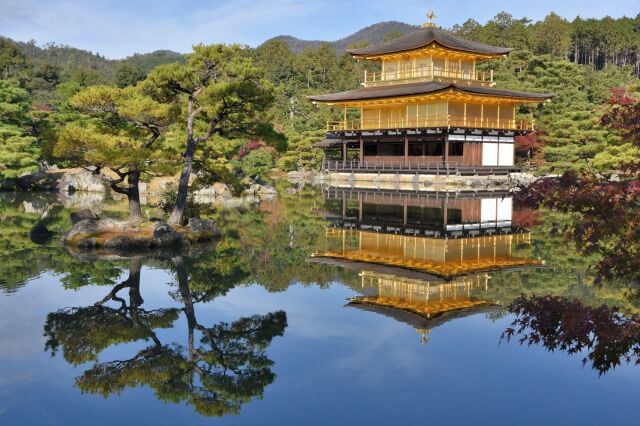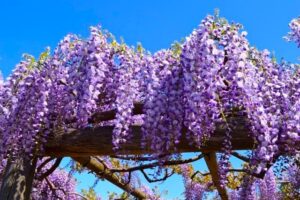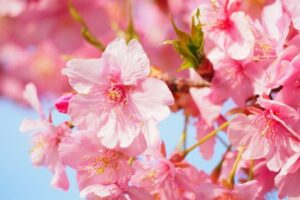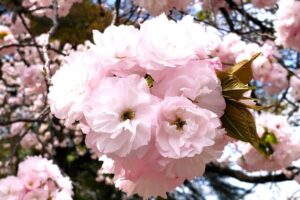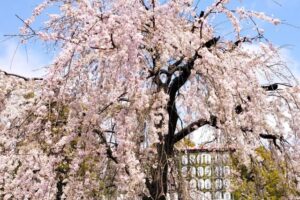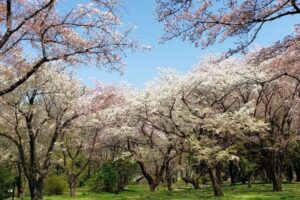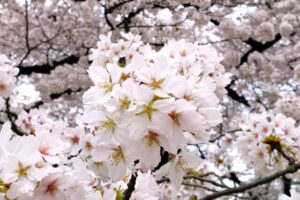外国人から「金閣寺って何ですか?」と聞かれたら、英語で答えられますでしょうか?
 woman
woman(「金閣寺」って何ですか?)



金閣寺って英語で何て説明すればいいのかしら?
外国人に金閣寺をどうやって説明すればいいのか?
そんな疑問にお答えします。
金閣寺は英語で「A temple in Kita Ward, Kyoto City.(京都市北区にある寺院)」です。



The official name is “Rokuonji”, but it is called “Kinkakuji” because it is famous for the building with gold leaf.
(金閣寺は、京都市北区にある寺院です。
正式名称は「鹿苑寺」ですが、金箔を貼った舎利殿で有名なため、「金閣寺」と呼ばれています。)
金閣寺について英語で説明する例文を一緒に見て行きましょう。
金閣寺を英語で説明
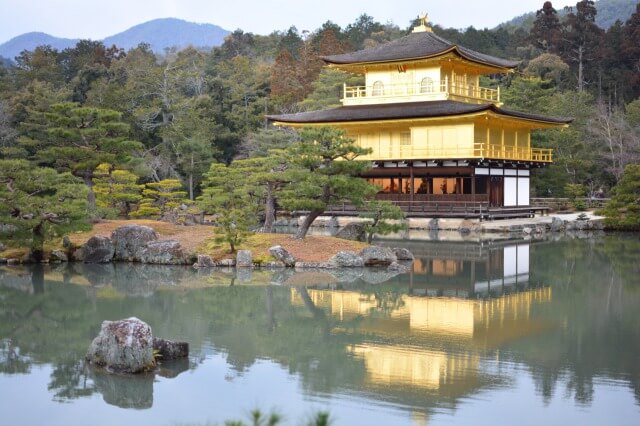

Kinkakuji is a temple located in Kita Ward, Kyoto City.
金閣寺は、京都市北区にある寺院です。
- temple/寺院
- located in/にある
- Ward/区
The official name is “Rokuonji”, but it is called “Kinkakuji” because it is famous for the building with gold leaf.
正式名称は「鹿苑寺」ですが、金箔を貼った舎利殿で有名なため、「金閣寺」と呼ばれています。
- official name/正式名称
- call/呼ぶ
- famous for/で有名
- building/建物
- gold leaf/金箔
舎利殿(仏の遺骨を安置する堂)は、正確にはreliquary hall(聖骨箱の(reliquary)建物(hall))ですが、なじみのない英語のため、building(建物)と表現しています。
In 1994, it was registered as a World Cultural Heritage Site.
1994年には、世界文化遺産に登録されました。
- register/登録する
- as/として
- World Cultural Heritage Site/世界文化遺産
It is also listed in history textbooks and is one of the representative tourist attractions in Kyoto.
歴史の教科書にも載っており、京都の代表的な観光名所の一つです。
- be listed in/に記載されている
- history textbooks/歴史教科書
- one of the/一つ
- representative/代表的な
- tourist attractions/観光名所



金閣寺の歴史を英語で説明
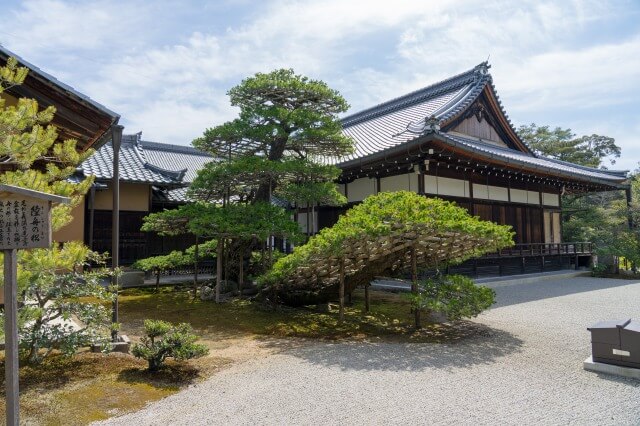

Originally, Saionji was built in the place where Kinkakuji was built.
金閣寺の建っている場所には、もともとは西園寺(さいおんじ)が建っていました。
- originally/もともと
- be built/建てられる
- place/場所
Saionji was built by Saionji Kintsune during the Kamakura period.
西園寺は、鎌倉時代に西園寺公経(さいおんじ きみつね)が建てたものです。
- be built/建てられる
- by/~によって
- during/間中
- period/時代
After the extinction of the Kamakura Shogunate, the rebellion of Saionji Kintsune was discovered, the territory was confiscated, and Saionji was also devastated.
鎌倉幕府滅亡後に西園寺公経の謀反(むほん)が発覚し、領地は没収され、西園寺も荒廃していきます。
- extinction/滅亡
- shogunate/幕府
- rebellion/謀反(むほん)
- discover/発見する
- territory/領地
- confiscate/没収する
- devastate/荒廃させる
In 1397, Yoshimitsu Ashikaga, the third shogun of the Kamakura Shogunate, took over this land and built “Kitayama-den (Kitayama-Dai)”.
1397年、鎌倉幕府第三代将軍足利義満がこの地を譲り受け、「北山殿(北山第)を建築します。
- third/三番目の
- Shogunate/幕府
- take over/引き継ぐ
After the death of Yoshimitsu Ashikaga and his wife, Kitayama-den became a Zen temple according to the will of Yoshimitsu Ashikaga, and was named “Rokuonji” from the posthumous Buddhist name of Yoshimitsu Ashikaga.
足利義満やその妻の死亡後、北山殿は足利義満の遺言により禅寺となり、足利義満の法号から「鹿苑寺」と名づけられました。
- death/死
- Zen/禅
- temple/お寺
- according to/による
- will/意志
- posthumous Buddhist name/法号
法号とは、亡くなってから葬儀までの間に僧侶に付けてもらう名前です。
法号を英語に訳すと、「posthumous Buddhist name」となります。
posthumous(死後の) Buddhist(仏教徒) name(名前)
日本語でも英語でも説明は難しいので、通じない場合は下記のように説明しておきましょう。
After Yoshimitsu Ashikaga death, it was named “Rokuonji” after Yoshimitsu Buddhist name “Rokuonin”.
足利義満の死後、仏教徒名「鹿苑院」にちなんで「鹿苑寺」と名付けられました。
- after/にちなんで



金閣寺の世界遺産登録を英語で説明
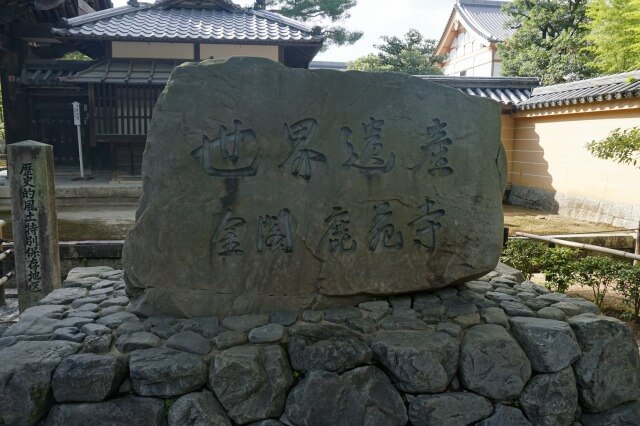

Kinkakuji was registered as a constituent asset of a World Cultural Heritage site in 1994.
金閣寺は、1994年に、世界文化遺産の構成資産に登録されました。
- register/登録する
- as/として
- constituent/構成要素
- asset/資産
- World Cultural Heritage site/世界文化遺産
The registered name of the World Cultural Heritage is “Historic Monuments of Ancient Kyoto (Kyoto, Uji and Otsu Cities)”.
世界文化遺産の登録名は、「古都京都の文化財(京都市、宇治市、大津市)」です。
- registered/登録された
- World Cultural Heritage/世界文化遺産
- historic/歴史的
- monument/記念碑
- ancient/古代の
This is the fifth World Heritage Site registration in Japan and consists of 17 temples and castles scattered in Kyoto, Uji and Otsu.
これは、日本で5件目となる世界遺産への登録で、京都市、宇治市、大津市に点在する17の寺社や城郭で構成されています。
- fifth/5番目の
- World Heritage Site/世界遺産
- registration/登録
- consist/成る
- temple/寺院
- castle/城
- scattered/散らばった



金閣寺の鳳凰を英語で説明
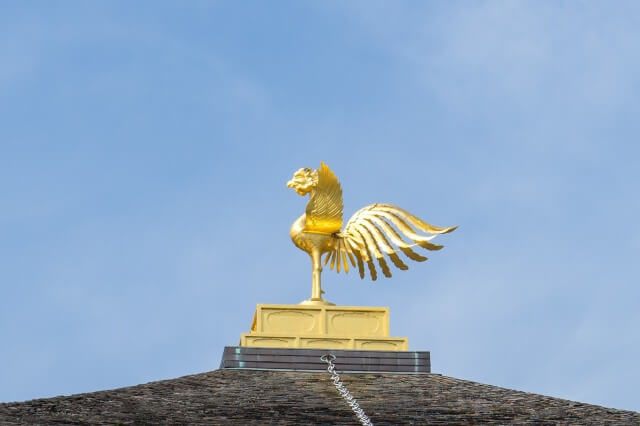

The phoenix is a legendary bird in Chinese mythology and is considered a symbol of power and eternal life.
鳳凰(ほうおう)は、中国神話の伝説の鳥で、権力や永遠の命の象徴とされています。
- phoenix/鳳凰(ほうおう)
- legendary/伝説の
- mythology/神話
- consider/考える
- symbol/シンボル
- power/権力
- eternal/永遠の
- life/命
A golden phoenix is installed on the roof of Kinkakuji Temple.
金閣寺の屋根の上には、金色の鳳凰が設置されています。
- golden/金色
- phoenix/鳳凰
- install/設置する
- roof/屋根
Generally, it is said that the phoenix was installed as a symbol of peace, but it is also said that Yoshimitsu Ashikaga installed it with the meaning that he is more suitable for the emperor than the current emperor.
一般的に、鳳凰は平和のシンボルとして設置されたと言われていますが、足利義満が現在の天皇より自分の方が天皇に相応しいという意味を込めて設置したとも言われています。
- generally/一般的に
- it is said that/と言われている
- phoenix/鳳凰
- install/設置する
- as/として
- symbol/シンボル
- peace/平和
- meaning/意味
- suitable/適切
- emperor/天皇
- current/現在の



金閣寺の金箔を英語で説明
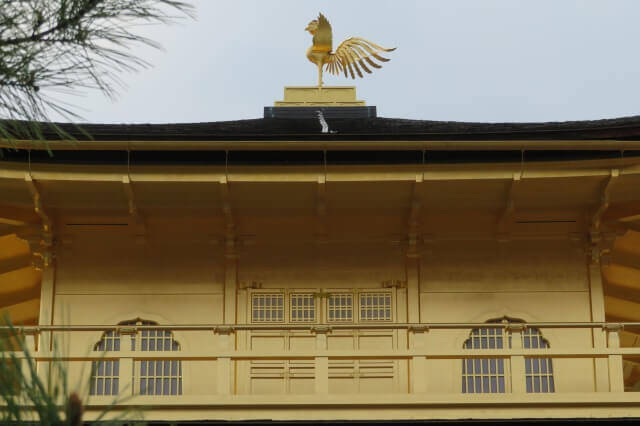

Kinkakuji is a three-story building, but gold leaf is pasted on the second and third floors.
金閣寺は3階建ての建物ですが、2階と3階に金箔が貼られています。
- three-story/三階建て
- building/建物
- gold leaf/金箔
- be pasted on/貼り付ける
- second floor/2階
- third floor/3階
It is said that about 20 kg of gold leaf was pasted in the gold leaf replacement work at Kinkakuji Temple, which began in 1986.
1986年から始まった金閣寺の金箔張替え作業では、約20キロの金箔が貼られたと言われています。
- it is said that/と言われている
- gold leaf/金箔
- paste/貼る
- replacement work/交換作業
- began/始まった(beginの過去形)
About 200,000 pieces of gold leaf (about 20 kg of gold) of about 10 cm square were used, and the total construction cost was 740 million yen.
約10センチ四方の金箔約20万枚(約20キロの金)を使用し、総工費は7億4千万円かかりました。
- piece/切れ
- gold leaf/金箔
- square/平方
- construction/建設
- cost/費用



(随分とたくさんの金箔が使われているのね。)
金閣寺放火事件を英語で説明
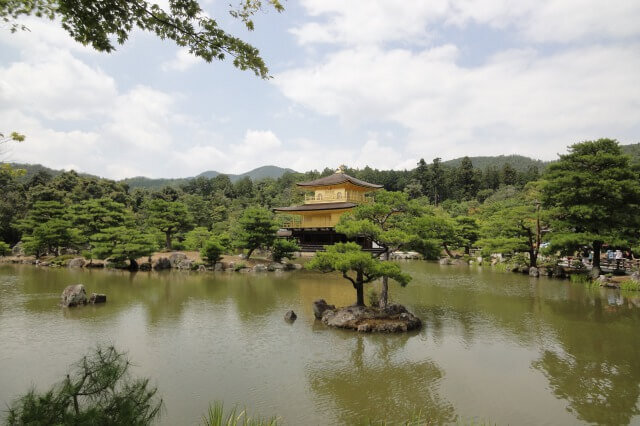

Kinkakuji was designated as a national treasure, but it was destroyed by arson in 1950.
金閣寺は国宝に指定されていましたが、1950年の放火により焼失しています。
- designate/指定する
- as/として
- national treasure/国宝
- be destroyed/破壊される
- arson/放火
The arson was set by a 21-year-old monk studying Buddhism at the time, and the building was burned down and 10 wooden statues were also burned down.
放火をしたのは当時21歳だった学僧で、舎利殿は全焼し10体の木像も焼失しました。
- arson/放火
- set/(わな・爆発物などを)仕掛ける
- monk/僧侶
- Buddhism/仏教
- at the time/当時
- building/建物
- burn/燃やす
- be burned down/焼け落ちる
- wooden statue/木像
The monk attempted suicide in the mountain behind the temple, but survived, and his mother, who was called for questioning, subsequently committed suicide.
学僧は寺の裏山で自殺を図ったが一命を取り留め、事情聴取に呼ばれた彼の母親は、その後、投身自殺しています。
- monk/僧侶
- attempt/試みる
- suicide/自殺
- mountain/山
- behind/裏の
- temple/寺
- survive/生き残る
- call/呼ぶ
- questioning/尋問
- subsequently/その後
- commit suicide/自殺する



三島由紀夫の金閣寺を英語で説明
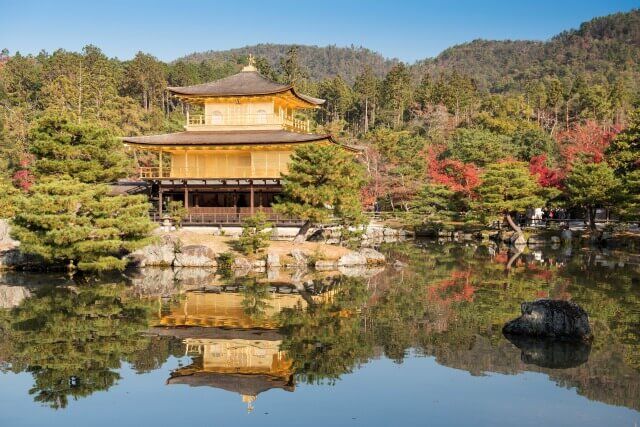

“Kinkakuji” is a novel written by Yukio Mishima.
「金閣寺」は三島由紀夫が書いた小説です。
- novel/小説
- written by/によって書かれた
Yukio Mishima was one of the leading writers of postwar Japanese literature and was also a candidate for the Nobel Prize in Literature.
三島由紀夫は戦後の日本文学を代表する作家のひとりで、ノーベル文学賞候補にもなりました。
- one of the/~の一つ
- leading writer/一流作家
- postwar/戦後
- Japanese literature/日本文学
- candidate/候補者
- the Nobel Prize in Literature/ノーベル文学賞
Yukio Mishima has established himself as a leading writer of Japanese literature by describing the process leading up to the arson of Kinkakuji by a monk studying Buddhism who was obsessed with the beauty of Kinkakuji.
金閣寺の美に取りつかれた学僧が、金閣寺に放火するまでの経緯を綴り、三島由紀夫が日本文学の代表的作家の地位を築いた作品です。
- establish/確立する
- as/として
- leading writer/一流作家
- Japanese literature/日本文学
- describe/描く
- process/経緯
- leading up to/に至るまで
- arson/放火
- a monk studying Buddhism/仏教を学ぶ僧侶
- be obsessed with/取り付かれる
- beauty/美
“Kinkakuji” is a long-selling novel with cumulative sales of over 3.3 million copies and has won numerous awards.
「金閣寺」は累計売上330万部を超えるロングセラー小説であり、数々の賞を受賞しています。
- long-selling/ロングセラー
- novel/小説
- cumulative/累計
- sales/売上
- million/百万
- copies/部
- won/win(得る)の過去形
- numerous/数々の
- award/賞



(金閣寺は日本の文学にも大きな影響を与えたのね。)
金閣寺を英語で説明|まとめ
いかがでしたでしょうか?
金閣寺は非常に有名なお寺なので、教科書や旅行のパンフレット等で一度は見たことがあるのではないでしょうか?
国宝に指定された舎利殿が放火されてしまったのは、非常に残念なことです。
しかし、それが文学作品の題材になるなど、金閣寺には非常に大きな文化的価値を感じます。
金箔が張り巡らされた豪華な舎利殿は、外国人から見ても非常に魅力的だと思います。
ぜひ、外国人の友人を誘って、日本の歴史を堪能してみて下さい。





